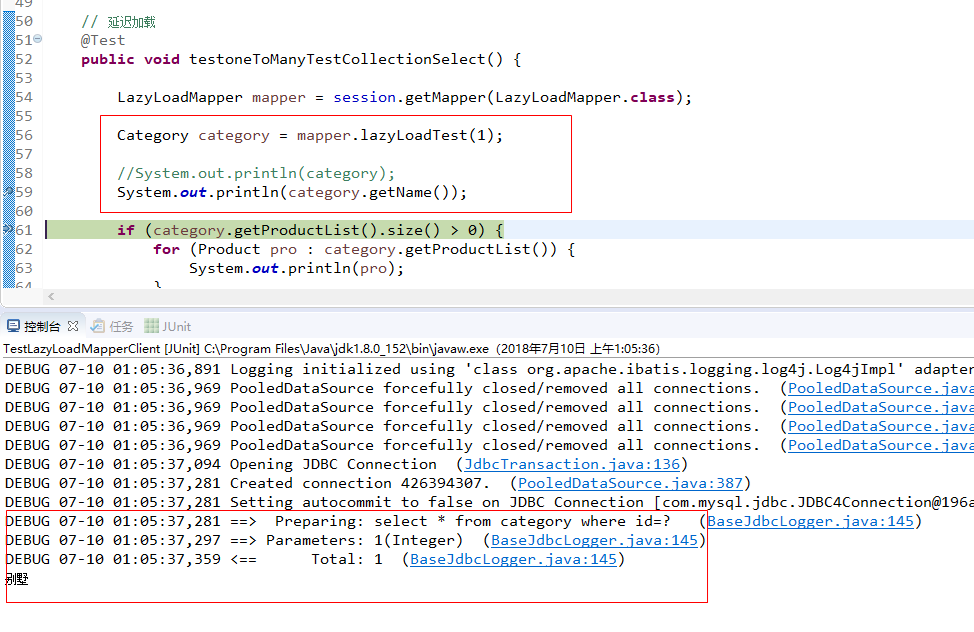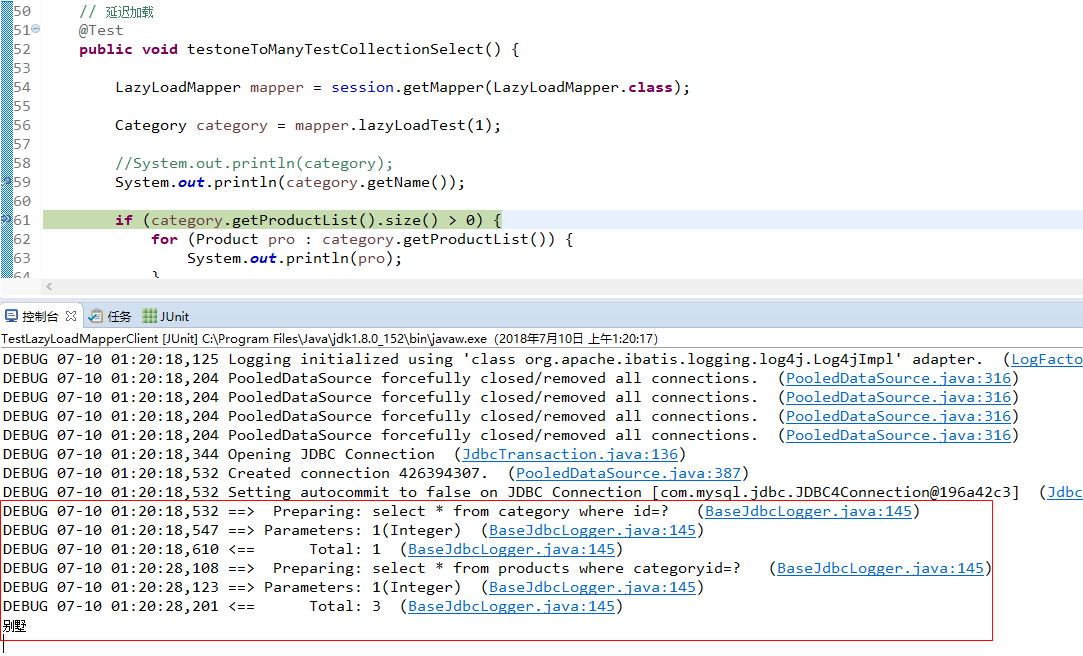Mybatis学习系列(六)延迟加载
延迟加载其实就是将数据加载时机推迟,比如推迟嵌套查询的执行时机。在Mybatis中经常用到关联查询,但是并不是任何时候都需要立即返回关联查询结果。比如查询订单信息,并不一定需要及时返回订单对应的产品信息,查询商品分类信息并不一定要及时返回该类别下有哪些产品,这种情况一下需要一种机制,当需要查看时,再执行查询,返回需要的结果集,这种需求在Mybatis中可以使用延迟加载机制来实现。延迟加载可以实现先查询主表,按需实时做关联查询,返回关联表结果集,一定程度上提高了效率。
Mapper.xml映射文件
以商品类别category和商品product为例,一个类别下可以有多个商品,一个商品属于一种类别。
编写lazyLoadMapper.xml映射文件
<?xml version="1.0" encoding="UTF-8"?> <!DOCTYPE mapper PUBLIC "-//mybatis.org//DTD Mapper 3.0//EN" "http://mybatis.org/dtd/mybatis-3-mapper.dtd"> <mapper namespace="com.sl.mapper.LazyLoadMapper"> <!-- 分类信息查询 --> <select id="lazyLoadTest" resultMap="lazyLoadProductsByCategoryTest"> select * from category where id=#{id} </select> <resultMap id="lazyLoadProductsByCategoryTest" type="com.sl.po.Category"> <id column="id" property="Id"></id> <result column="name" property="Name"></result> <result column="remark" property="Remark"></result> <!-- 一个分类对应多个产品,此处使用collection --> <collection property="productList" ofType="com.sl.po.Product" column="id" select="selectProductsByCategoryId"></collection> </resultMap> <!-- 嵌套查询返回商品信息,延迟加载将要执行的sql --> <select id="selectProductsByCategoryId" resultType="com.sl.po.Product"> select * from products where categoryid=#{id} </select> </mapper>
启用延迟加载和按需加载
Mybatis配置文件中通过两个属性lazyLoadingEnabled和aggressiveLazyLoading来控制延迟加载和按需加载。
lazyLoadingEnabled:是否启用延迟加载,mybatis默认为false,不启用延迟加载。lazyLoadingEnabled属性控制全局是否使用延迟加载,特殊关联关系也可以通过嵌套查询中fetchType属性单独配置(fetchType属性值lazy或者eager)。
aggressiveLazyLoading:是否按需加载属性,默认值false,lazyLoadingEnabled属性启用时只要加载对象,就会加载该对象的所有属性;关闭该属性则会按需加载,即使用到某关联属性时,实时执行嵌套查询加载该属性。
SqlMapConfig.xml中修改配置,注册lazyLoadMapper.xml
<settings> <!-- 启用延迟加载特性,不配置默认关闭该特性--> <setting name="lazyLoadingEnabled" value="true"></setting> <!-- 按需加载: false:使用关联属性,及时加载; true,加载对象,则加载所有属性, --> <setting name="aggressiveLazyLoading" value="false"/> </settings> <mappers> <!-- 注册Mapper.xml文件 --> <mapper resource="mapper/lazyLoadMapper.xml"></mapper> </mappers>
运行测试
添加mapper接口

package com.sl.mapper; import java.util.List; import com.sl.po.Category; import com.sl.po.Product; public interface LazyLoadMapper { Category lazyLoadTest(int id); //嵌套查询 List<Product> selectProductsByCategoryId(int cId); }
测试方法

package com.sl.test; import java.io.IOException; import java.io.InputStream; import java.math.BigDecimal; import java.text.DateFormat; import java.text.ParseException; import java.text.SimpleDateFormat; import org.apache.ibatis.io.Resources; import org.apache.ibatis.session.SqlSession; import org.apache.ibatis.session.SqlSessionFactory; import org.apache.ibatis.session.SqlSessionFactoryBuilder; import org.junit.Before; import org.junit.Test; import com.sl.mapper.LazyLoadMapper; import com.sl.mapper.ProductMapper; import com.sl.mapper.UnitMapper; import com.sl.po.Category; import com.sl.po.Product; import com.sl.po.ProductDetailInfo; import com.sl.po.ProductInfo; import com.sl.po.ProductVo; import com.sl.po.User; import java.util.ArrayList; import java.util.Date; import java.util.HashMap; import java.util.Iterator; import java.util.List; import java.util.Map; public class TestLazyLoadMapperClient { // 定义会话SqlSession SqlSession session = null; @Before public void init() throws IOException { // 定义mabatis全局配置文件 String resource = "SqlMapConfig.xml"; InputStream inputStream = Resources.getResourceAsStream(resource); SqlSessionFactoryBuilder builder = new SqlSessionFactoryBuilder(); SqlSessionFactory factory = builder.build(inputStream); // 根据sqlSessionFactory产生会话sqlsession session = factory.openSession(); } // 延迟加载 @Test public void testoneToManyTestCollectionSelect() { LazyLoadMapper mapper = session.getMapper(LazyLoadMapper.class); Category category = mapper.lazyLoadTest(1); //System.out.println(category); System.out.println(category.getName()); if (category.getProductList().size() > 0) { for (Product pro : category.getProductList()) { System.out.println(pro); } } // 关闭会话 session.close(); } }
运行程序查看sql执行记录:

当前配置:启用延迟加载lazyLoadingEnabled=true和按需加载aggressiveLazyLoading=false
Step1: 执行Mapper方法lazyLoadTest,实际只执行了select * from category where id=#{id}
Step2: 执行System.out.println(category.getName()),加载属性,由于启用按需加载aggressiveLazyLoading=false,name属性此前已加载好,所以此处无数据库交互
Step3: 执行category.getProductList().size(),加载属性productList,按需加载需要执行延迟加载sql脚本select * from products where categoryid=#{id},与数据库交互
将aggressiveLazyLoading属性设为为true,即:
<setting name="aggressiveLazyLoading" value="false"/>
再一下执行过程:

此时的配置:启用延迟加载lazyLoadingEnabled=true和关闭按需加载aggressiveLazyLoading=true(即加载对象则加载所有属性)
Step1: 执行Mapper方法lazyLoadTest,实际只执行了select * from category where id=#{id}
Step2: 执行System.out.println(category.getName()),访问name属性,由于启用按需加载aggressiveLazyLoading=true,关闭按需加载,则加载category对象时加载该对象的所有属性,执行延迟加载sql脚本select * from products where categoryid=#{id},与数据库交互
Step3: 执行category.getProductList().size(),访问productList属性,该 性step2已加载好,此处无需数据库交互
对比上下两个step2可以发现 aggressiveLazyLoading=true /false的区别。



